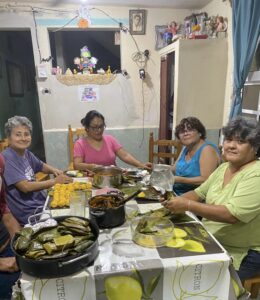Authored by María Inés Canto, professor of Spanish
Among the contemporary Mayan community of the Yucatan Peninsula, in southeastern Mexico, celebrating Hanal Pixan (“Food for the Souls” in Mayan language), or Day of the Dead, is a community, family, and intimate act. The altar is created at home for deceased relatives and friends. In some communities, a small altar is built outside the house for the lonely soul, that soul who is no longer remembered and has nowhere to go. This celebration also coincides with the harvest of jicama, espelón — the endemic bean of the Yucatan peninsula —, squash, and corn, all fundamental ingredients for preparing traditional foods for the Day of the Dead altar.
Harvest times and celebrating death are intimately linked, thus creating an indissoluble root. Honoring life and food while honoring death. This is what many anthropologists have called circular, cyclical time. The Day of the Dead is also the space for a dual, non-hierarchical history, utterly alien to the extractivist capitalism that subtracts metals, minerals, and territory to accumulate 82% of global wealth in 1% of the population.

In this sense, celebrating the Day of the Dead ritual in the here and now of its geographical space is an act of resistance. The altar is built as a portal in time to invite the dead to share food. These days in Mexico, people want to feel the dead, take their hands, and sit with them at the table, at the same level as the living. This holding hands with the deceased is not a solitary or heroic act. It is a collective, communal, loving, and contradictory process in which mourning, laughter, solemnity, and music are mixed to contain the planes of life and death.
If something is built, it is the feeling of empathy. Empathy is an anti-capitalist concept because it is not something we use; it is something that is created with the other, for, and along the other. That is why death can take space without euphemisms or magical charms. Time is shared and passed through the heart when the dead are remembered.
The altar as a portal

The altar is, without a doubt, the best-known symbol globally, along with La Catrina and the scull sugar that Coco (2017) made famous worldwide. It might look like a theme party, something to be admired and photographed, perhaps as some ephemeral and uncomfortable source of pleasure for societies with another relationship with death. However, the altar, in addition to being that symbol of a portal in time, is the field in which the rite of memory is cultivated in the oral transmission of familiar forms, colors, and elements. The altar as an image is only activated in the exercise of the community that creates it. The altar is made for the dead so that these invisible witnesses exist among the living for a few days. To stand before the altar is to witness absence. It is to experience time and the people who, through action and memory, sustain this rite in the duality of history. I use duality, from the dimension that the Argentinian anthropologist Rita Laura Segato gives her in her “Theory of Roots,” when she studies the dynamics of the native peoples of South America. The dual history of a community, in which the history of women and men is intertwined.

The ritual among the Mayan rural communities of the Yucatan peninsula is a dual task between men, women, children, and non-binary people. Meanwhile, the women, very early in the morning, prepare the stews for the pib or mucbipollo: they grind the corn, clean, and toast the banana leaf to prepare a kind of giant tamal, a body embalmed in achiote and epazote and covered in banana leaf. The men and the children oversee opening a hole in the earth, lighting the coals, and placing the stones in an underground oven to transform the food. The mouth of the burning soil receives those corn bodies prepared by the women, and the men put palms, trunks, herbs, and a layer of earth to seal the underground oven that will cook the food. Memory is woven between cooking the food, setting up the altar, and preparing the soil. In this bustle of coming and going, the transmission of knowledge about the textures of food and the earth’s temperature occurs. It is a living and undulating cosmos between life and death.
An act of a community
It is important to note that the rituals are different throughout the country. In the north, there is a profound relationship with water. Visiting death on boats on Lake Pátzcuaro, Michoacán, is a tradition. In central Mexico, it is more common to go to the cemeteries, clean, and watch over the graves while eating and listening to music in the holy field. In any of its manifestations, the altar is a living entity, built hand in hand with family, among neighbors and friends. It is a community act. Throughout the country, altars are made in schools, offices, and family homes, traditional food is shared, and there are Christian prayers syncretized with the ways of native cultures to celebrate and communicate with death. The altar is set up as the proof of the portal of time that opens for a couple of days a year. The altar is witness and food simultaneously. The children enjoy the food, sweets, chocolate, and bread on the altar for the dead. The altar is dismantled, the candles are extinguished, and the portal is closed until next year. These traditions are transmitted in the doing, in the resemblance and imagination of the crossing worlds between the living and the dead.
This celebration of death disrupts the country’s public space for 2 or 3 days to face this capitalist world that keeps public spaces untouched, orderly, and in need of the future and constant technological modernity. The dual tradition experienced in rural communities is practically impossible in overcrowded cities on the peninsula. The Yucatán peninsula is facing a deforestation crisis due to the recent construction of luxury housing complexes, the gentrification of popular neighborhoods, and the forestry crime caused by the construction of the recently inaugurated (Agosto, 2023) Mayan Train by President Andrés Manuel López Obrador.
A portal to the present
The Day of the Dead celebration is rooted in a geography that we politically know today as Mexico. However, as the Mixe philosopher and linguist Yásnaya E. Aguilar Gil reminds us, Mexico is a political creation that encloses multiple native nations colonized in the sixteenth century, later encapsulated in what is now Mexico. In this diverse, cross-cultural, unequal, and multilingual reality, the population experiences rampant violence that began in 2006 when President Felipe Calderón declared “The War on Drugs” in 2006. By the end of 2022, more than 109,000 people had disappeared (The San Diego Union Tribune). On average, 26 people go missing daily. Just as in the 1970s, mothers in Argentina organized to search for their disappeared children, the Searching Mothers (Madres buscadoras) in Mexico look for the clandestine graves of organized crime and try to find their daughters and sons among the human remains. In parallel, 11 women are victims of femicide per Day in the country. Mexico is the second most dangerous country for a woman; the first is Brazil, with 13 women murdered daily just for being a woman. Respectively, Brazil and Mexico have the most trans feminicides around the globe.
In this context, reflecting on the Day of the Dead in Mexico is to talk about this present moment torn between war, institutional impunity, and the tireless activism of women and native communities that resist the dispossession of territories that endanger environmental security and cultural ties. So, pausing to place the altar for the Day of the Dead is a tradition that creates community while reflecting on the present and the past with that invisible thread that sustains the cultural fabric of the roots of many nations without a state, inside and outside the borders of what we now call Mexico.

María Inés Canto is an Assistant Professor of Spanish in Modern Mexican Literature and Culture. She holds a Ph.D. in Hispanic Languages and Literatures (2016) and an M.A. in Portuguese and Brazilian Literatures (2015) from the University of California, Santa Barbara. Her research engages with the relationships of literature and visual arts.
Celebrate The Day of the Dead
The Department of Languages, Literatures, and Cultures, we will be celebrating for two days on the LSC Plaza with an in person and virtual altar, that will feature free food and coffee, face painting, and a showing of Disney’s COCO on November 1 in the Behavioral Science Building.
We invite all to join us and to submit the names and pictures of lost loved ones to our virtual altar here: Day of the Dead 2023 – Languages, Literatures and Cultures | Colorado State University (colostate.edu)